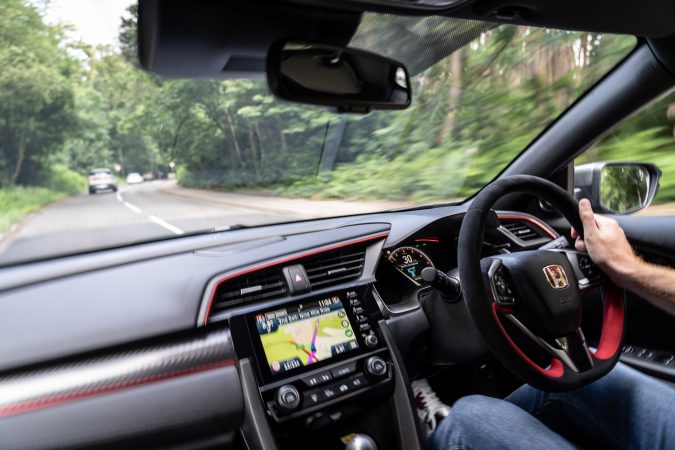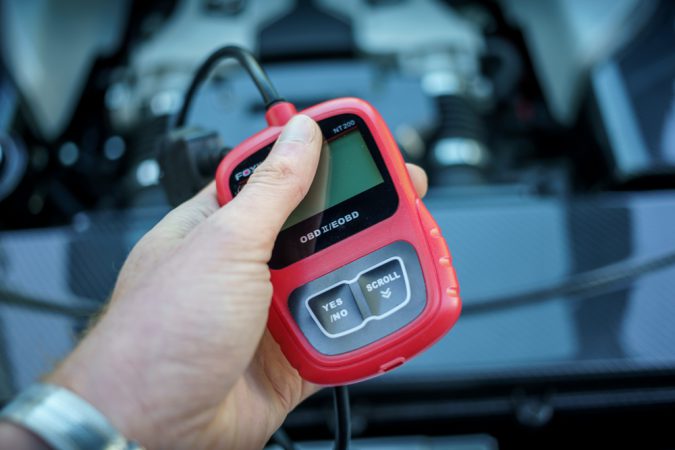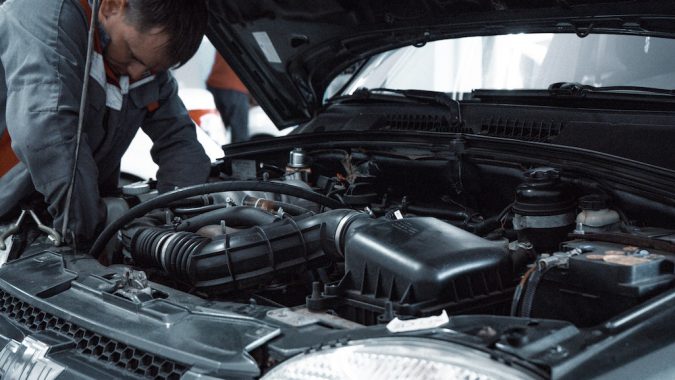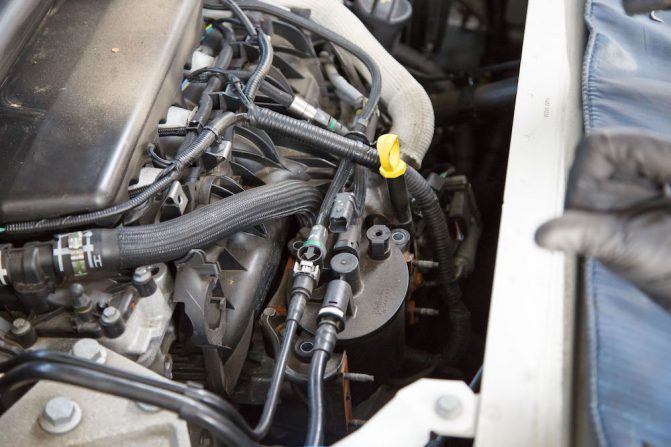Your engine is making weird noises, so naturally, you take it into the repair shop. Then your mechanic tells you that you need a new crankshaft position sensor. But what in the world is that? Well, worry not, that’s why we make these articles: to help you understand your car better and make informed repair decisions. We’ll discuss all the possible crankshaft position sensor symptoms so you can verify the problem. And of course, the repairs that you will need to do as well as its costs.
What’s A Crankshaft And A Crankshaft Position Sensor?
Not everyone knows what a crankshaft is, let alone the crankshaft position sensor, and we don’t blame you. It’s an internal engine part that sits deep within the engine. We’ll explain briefly about crankshafts before we get to the crankshaft position sensor symptoms so that you’ll have a better understanding of why your car may need repairs.
The crankshaft is a mechanical part of the engine that converts reciprocating motion into rotational motion. It consists of a series of cranks and crankpins that connects to the engine’s pistons via a connecting rod. When the engine is running, pistons would move up and down. The crankshaft then uses this reciprocating motion to rotate the shaft.
At the end of the shaft sits a flywheel. The flywheel serves two purposes: first, to balance the crankshaft in case of irregular engine pulses. And secondly, to transfer the power from the engine. So to summarize, it’s basically a mechanical device to convert motion and energy from the engine into the flywheel, then to the transmission, and ultimately to the wheels.
To better understand the operation of the crankshaft, we recommend watching this video below:
Is It The Same As A Camshaft?
No, but the two work together. The camshaft is a mechanical device that controls the opening and closing of the engine’s valves. A camshaft has lobes that will come in contact and pushes the valves. When it pushes a valve, it will open it and then the valve would retract and close afterward.
The crankshaft and camshaft are connected via either a timing belt or chain or sometimes via a gear drive depending on the car’s make and model. They’re connected because the two components have to work in unison. For example, when the piston in cylinder 1 goes down during an intake stroke, the camshaft has to open the intake valves to allow fuel and air to enter the cylinder.
If the timing is off, for example, because of a slipping belt, the camshaft will open the incorrect valve. This will lead to the engine running rough and possibly damaging it. That’s why the timing between the crankshaft and camshaft has to be correct, although this role falls to the timing belt or chain rather than the crankshaft. The crankshaft is there as a reference for the camshaft for when to operate.
What’s The Crankshaft Position Sensor Is For Then?
The crankshaft position sensor or sometimes called crank sensor is an electronic device to monitor the rotational speed and position of the crankshaft. This information is transferred to the Engine Control Unit (ECU). Then the ECU can make appropriate adjustments according to the information from the crank sensor, such as to the fuel injection and ignition system timing.
The crankshaft speed and position are very important parameters, and that’s why the sensor is important. A faulty sensor will feed the wrong information, preventing the ECU from making the correct adjustments when necessary. For example, let’s say the ECU needs to inject fuel into cylinder 2. But because the sensor is faulty, it’s injecting fuel into other cylinders instead.
As a result, cylinder 2 won’t be getting fuel at the correct timing. This means the cylinder won’t fire at the correct timing, resulting in engine misfires. If you’re starting the car, it may prevent the engine from starting altogether.
This video from M-Tech Automotive is a little old, but it explains how the crankshaft position sensor works in great detail:
Why Does The Crankshaft Position Sensor Go Bad?
The crank sensor mainly goes bad because of one of two reasons: first, an overheating engine. If an engine is overheating, the extreme heat can damage the sensor. This is because the plastic covering of the sensor can melt under extreme heat. This is one of the many reasons why you shouldn’t ignore an overheating engine.
The second reason is circuitry problems, which are probably the most common cause of electrical failures in a car. This can occur because of the faulty voltage that the sensor received. Additionally, loose, worn-out, or damaged wiring because of age can also break the sensor.
Crankshaft Position Sensor Symptoms
So, now you know how a crankshaft and the cranks sensor works. Next, let’s discuss the crankshaft position sensor symptoms. Here are the symptoms you might see when you have a faulty crankshaft position sensor:
1. Difficulty Starting The Engine
As mentioned, the crank sensor tells the ECU what adjustments to make to the engine. Such as when to operate a fuel injector or adjust the ignition timing. If the sensor is faulty, it will make incorrect adjustments and this can lead to difficulty starting the engine.
For example, let’s say that cylinder 1 is currently in its compression stroke. This is the stroke where the piston will move up to compress fuel and air, and the spark plug will need to fire to combust the fuel. If the sensor is faulty, it might tell the ECU that cylinder 1 is in its intake stroke even though it’s not. This causes the ECU to tell the ignition not to fire, resulting in fuel and air in cylinder 1 not combusting.
When the engine is off and the cylinders aren’t firing properly, the engine won’t run. Leaving you with an engine that refuses to turn on.
2. Stalling Engine
Another common crankshaft position sensor symptom would be the engine suddenly stalling out of nowhere. Again, if the sensor feeds incorrect information to the ECU, this can disrupt the engine operation. This can lead to the engine shutting off out of nowhere.
There are of course many reasons why an engine stalled since it’s so complex. For example, a bad fuel pump won’t be able to pump fuel into the engine, leading to the engine stalling since it’s not getting enough fuel. Other electrical problems may also cause the engine to stall. If all electrical accessories also shut off, this means you have a wider electrical problem rather than just the crank sensor.
3. Misfiring Engine And Reduced Acceleration
This symptom might appear before the engine stalls. An engine misfire is when one or more cylinders in the engine aren’t firing at the correct time. This will feel like the engine missed a beat and hesitating under acceleration. Under normal conditions, the engine’s RPM should climb linearly when accelerating. If the RPM is hesitating, this is a sign of an engine misfire.

Of course, engine misfires can happen because of several reasons. The internal combustion engine is very complex with tons of components that can go wrong. For example, a faulty spark plug that isn’t firing can also cause an engine to misfire since it won’t combust the fuel and air mixture inside a cylinder.
Other common causes for misfiring engines include bad ignition coil, bad fuel injectors, and clogged air intake. You will need to do some troubleshooting to identify the root cause of the problem.
4. Poor Gas Mileage
The ECU uses the crankshaft position sensor – along with other sensors – to adjust the fuel injectors. A faulty sensor may cause the injectors to put in more fuel than necessary, reducing the gas mileage when driving the car under seemingly normal driving conditions.
Since other sensors also play a role, another sensor may be causing this problem rather than the crank sensor. For example, your car has a Mass Air Flow (MAF) sensor. This is a sensor that detects how much air is getting into the engine. The engine needs this sensor to monitor fuel and air mixture since engines ideally should run on a stoichiometric ratio. That is a 14.7:1 ratio, that’s 1 gram of fuel for every 14.7 grams of air.
If the engine is running lean (too much air), the ECU will tell the fuel injectors to put in more fuel to balance the mixture. A faulty MAF sensor may be telling the ECU that the engine is running lean even though it’s not. The fuel injectors will then put in more fuel even though it’s not necessary, leading to poor gas mileage.
5. Check Engine Light
The check engine light is your car’s way of telling you that there’s something wrong with a powertrain component. Modern cars have an On-Board Diagnostic (OBD) system where it monitors the rest of the car’s electronics for errors. When it detects an error, the system will try to make adjustments accordingly to fix the problem.
If it can’t fix the error, it will register an error code which will trigger the check engine light to alert the driver that there’s a problem. Seeing that dreaded amber light is unnerving, to say the least, but it can also be a blessing in disguise. When you see a check engine light, you can scan the car’s OBD system to find out the error code. This makes it easier for you to diagnose the problem, rather than having to spend hours to find out the problem mechanically.
Not every problem will register an error code, making it difficult to diagnose certain problems. Thankfully, there is an error code for a faulty crankshaft position sensor. The P0355 is a trouble code for “Crankshaft Position Sensor ‘A’ Circuit Malfunction. This indicates a problem with the crank sensor and can be caused by things such as a short in the wiring, sensor failure, or a damaged signal plate.
Keep in mind that this code may also come up because of a bad timing belt or chain. So, you’ll need to check that as well. If the timing belt or chain is fine, it’s likely the culprit is the crankshaft position sensor.
Troubleshooting Crankshaft Position Sensor
Even if you see the crankshaft position sensor symptoms above, you will need to troubleshoot your engine to find out the exact cause. As mentioned, if the check engine light comes on, then this makes troubleshooting easier since you can scan the OBD system to find out what’s causing the symptoms.
If your car was made after 1996, then you likely have an OBD-2 system. If your car was made before that, it probably has an OBD-1 system. Make sure that you get the correct OBD scanner, and don’t worry, OBD-2 scanners work universally on all cars. Once you got the correct scanner, here’s how to scan the OBD system:
Scanning The OBD System
- Plug the scanner into the car’s OBD port. This port is often located underneath the dashboard area, either above your pedals or knee. Check your owner’s manual or online to see where it’s located in your car.
- Once plugged in, turn on the OBD scanner. It should immediately scan the car. However, some scanners might require you to input additional information such as make, model year, VIN, etc.
- After the scan, it will display the error codes that the system has registered. As mentioned, if you see a P0355 code, then this indicates a crank sensor issue. But this can also mean that the timing belt/chain is faulty.
Since the timing belt/chain can also trigger this error code, you will need to check your car’s timing belt or chain. If you hear a rattling noise coming from the engine, then you may have a timing belt or chain issue. If your car uses a timing belt, it needs to be changed every 65,000 miles. While timing chains need to be replaced every 120,000 miles.
If your car has reached its timing belt/chain change interval and you haven’t had it changed, then you may have a timing belt/chain issue. If it’s fine, then it’s confirmation that the crank sensor is faulty and you will need to replace it.

Other error codes might also pop up in the scan, you’ll need to check with your owner’s manual on what those codes mean. If your car is refusing to start at all and the crank sensor isn’t the problem, we’ve written a handy guide on how to diagnose a car that won’t start.
Crankshaft Position Sensor Replacement Cost
So, now you’ve verified that the crankshaft position sensor is faulty. How much is it to replace it then? As always, the cost will vary depending on your car’s make and model. But on average, it will cost somewhere around $200 – $300 for most cars, including labor costs. The part itself is usually around $50 – 150, while labor is somewhere around $100 – $200 for a crank sensor replacement job.
As an example, an OEM crank sensor for a 2010 Toyota RAV4 (and certain other Toyota models as well) is around $131. Assuming you have to pay $150 for the labor, that’s a total of $281 for a crankshaft position sensor replacement. Needless to say, this number can easily go up if you drive a luxury or performance car.
Crankshaft Position Sensor DIY Replacement
If you don’t feel like paying $150 in labor cost, then you can replace the crankshaft position sensor yourself. However, depending on your car’s make model, this may not be an easy job to do. This is because in some cars, gaining access to the sensor may require you to remove certain components such as the starter motor.
If you’re not entirely sure about your mechanical skills, doing a job like this yourself may cause more harm than good. Check your owner’s manual to see where the crankshaft position is located. If you don’t have to remove other components, or you’re sure of your mechanical skills, here’s how to remove them:
How To Replace Crankshaft Position Sensor
- As a safety measure, you should disconnect the car’s battery first. Make sure you’re working in a dry environment, an indoor garage is ideal.
- It may help to lift your car. Jack up the front of the car, and put it on a jack stand. Make sure the parking brake is on and use wheel chocks to prevent the car from moving.
- Locate the crankshaft position sensor. They will usually sit against the timing belt/chain cover or on the front of the engine block. Remove any components necessary to reach the sensor.
- Most sensors will have three wires: an input, output, and a ground wire. Remember these, take a photo, or draw a diagram so that you’ll connect them correctly when you install the new sensor.
- Remove the wires and electrical connectors.
- The sensor is usually held in place by one or two bolts, remove these bolts and then remove the crankshaft position sensor. A flathead screwdriver may help you to pry the sensor out, but be careful not to apply too much pressure as it can break the sensor.
- Clean the port with a clean rag and lubricate the new o-ring to help install it properly.
- Insert the new crankshaft position sensor. You should hear a click when it’s installed properly, then put the sensor bolts back in and tighten to about 2-3 foot-pounds.
- Reconnect the sensor wiring.
- Reconnect the battery and start the car and see if the car runs smoothly. If it does, pat yourself on the back cause you’ve done a good job.
Questions & Answers
Got any more questions about crankshaft position sensor symptoms? We’ll try to answer as many questions below:
Can I Drive With A Bad Crankshaft Position Sensor?
If you have a bad crankshaft position sensor, your car may not start at all. If you can get it to run, it’s generally a bad idea to ignore the problem. As mentioned, a bad sensor can cause your engine to stall suddenly. This can be dangerous as you can lose control of the car. This puts you and everyone around you at significant risk.
If that’s not enough to stop you from driving a car with a bad crank sensor, the fact that it can lead to much more expensive damages may stop you. Ignoring the problem can damage your engine’s internals since they can’t operate properly. For example, engine misfires can damage the engine’s pistons.
When internal engine parts are damaged, you will essentially need an engine rebuild. Another problem it can cause is that if the engine runs rich (too much fuel) for an extended period, it can damage the catalytic converter. This turns a $300 repair job, into a $2,000 repair job. Bottom line, if you see any faulty crankshaft position sensor symptoms, don’t ignore the problem.
How To Reduce Crankshaft Position Sensor Replacement Cost?
As mentioned, you can replace the crankshaft position sensor yourself. This will save you at least $100 from labor costs. If it’s still too expensive, you can consider getting an aftermarket crankshaft position sensor. An aftermarket part is a replacement part that is made by a third-party manufacturer, and not the car’s original manufacturer. For example, AutoZone has a lot of aftermarket crank sensors available.

These aftermarket parts are often under $100, making them quite a bit cheaper than OEM parts. But before you buy them, make sure they will fit your car’s make and model. There’s no point in buying a cheaper part only to find out that it doesn’t work with your car.
Additionally, remember to read customer reviews. Make sure previous customers are happy with their purchase, as aftermarket parts may be of a lower quality, although that’s not always the case. But it’s better safe than sorry. And finally, find a part that has a warranty if possible.
How Maintain Crankshaft Position Sensor?
The crankshaft position sensor isn’t a part that requires any maintenance. And like many other electrical components, there are no estimates on their lifespan. Sometimes, it will just fail due to age, or possibly bad design or bad installation process. The one thing you can do to extend its lifespan is to keep the engine operating temperatures at an optimum.
As mentioned, overheating can damage the plastic cover thus damaging the sensor. So, preventing your engine from overheating will prolong the life of the sensor. General cooling system maintenance should be good enough to keep the engine from overheating. But once you reach around 100,000 miles, you will need to do radiator flushes more frequently.
Keep an eye on that temperature gauge. If you notice it going higher than usual, then don’t ignore it. This will prevent damage to the crank sensor, and to the engine in general. Read our guide to radiator flushes to learn more about overheating engines.
Facts: Signs of a Faulty Crankshaft Position Sensor
- The crankshaft position sensor monitors the position and rotational speed of the crankshaft and sends the information to the engine control unit.
- Overheating engine and circuitry problems are common causes of problems with the crankshaft position sensor.
- A failing crankshaft position sensor can lead to difficulty starting the vehicle or intermittent stalling.
- An illuminated Check Engine Light can also be a sign of a potential problem with the crankshaft position sensor.
- Uneven acceleration and engine misfires or vibrations can result from inaccurate input from the crankshaft position sensor.
- Rough idling or a vibrating engine can also be a sign of a crankshaft position sensor problem.
- Lacking accurate timing information from the sensor can reduce gas mileage.
- The crankshaft position sensor is critical to proper engine functionality and performance.
- Driving with a faulty crankshaft position sensor can lead to long-term vehicle damage and expensive repairs.
- It is highly recommended to have a professional technician diagnose and replace the crankshaft position sensor if necessary.
Conclusion
The crankshaft is essential to the car’s operation, and the crankshaft position sensor helps the car’s ECU to make appropriate adjustments should the engine needs it. It’s just one of the many sensors in your car that helps it to run smoothly. If you see any of the crankshaft position sensor symptoms that we mentioned, do not postpone the repairs. This can result in further and expensive damage to the engine, and potentially be very dangerous.

